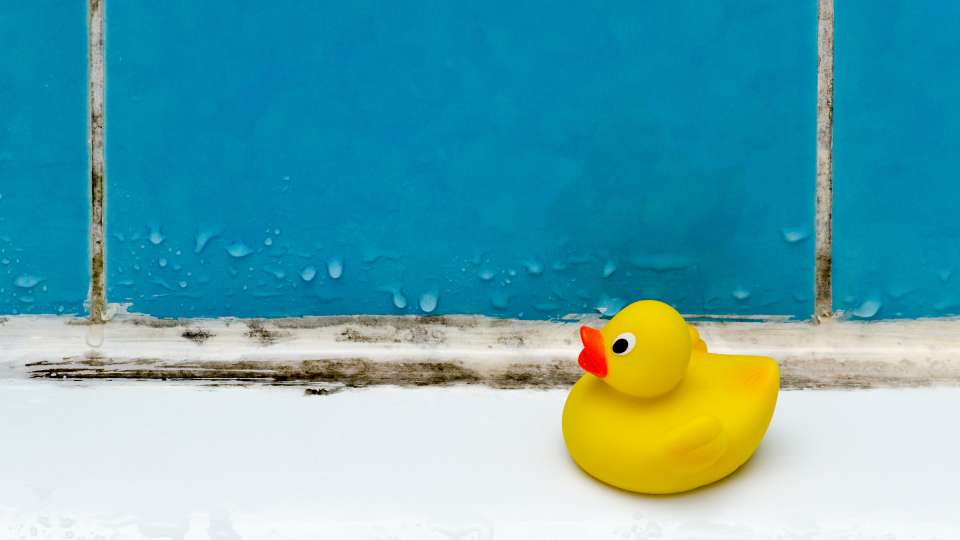Got Mold? Here’s How to Know If You Should Worry—And How to Prevent It

At the tail end of a long rainy season, the Pacific Northwest is rewarded with cherry blossoms, camellias and magnolias in bloom. It’s not all beautiful flowers, bright green grass and magical-looking moss, though. Rainy season also creates the perfect environment for mold—sometimes lots of it—to invade our homes.
Mold thrives in moist environments, such as bathrooms, kitchens and basements. And it’s more likely to come out during Seattle’s fall, winter and early spring months when it’s wet out and there is a more dramatic temperature difference between the indoors and outdoors, explains Brandon Kemperman, an occupational health and safety specialist for Environmental Health & Safety at the University of Washington. When it’s chilly and damp outside and toasty inside, condensation can form on surfaces in your home—especially if there isn’t adequate ventilation—that are ideal breeding grounds for mold.
Not only is mold less appealing to the eye than spring blooms, it also can destroy your belongings and may contribute to nagging allergy symptoms in some people.
Mold exposure and your health
Most people automatically assume mold exposure, especially black mold exposure, causes poor health. But that’s not always the case, says Lahari Rampur, M.D., who practices at the Allergy, Asthma and Immunology Clinic at UW Medical Center.
“There are hundreds of types of mold that do not cause any symptoms at all, and not all mold is bad,” she says.
The symptoms of mold exposure, which appear like allergy symptoms (runny nose, itchy eyes, sore throat), generally only occur if you have an allergy to mold. If you have an underlying condition that compromises your immune system, severe mold and fungal infections can occur. In rare cases, a type of mold hypersensitivity that causes lung disease can present with severe asthma-like symptoms, such as coughing, difficulty breathing and chest tightness, which are difficult to control with regular asthma medications, says Rampur.
You can find out if you are allergic to molds by scheduling an allergy skin test with an allergist. In some cases, blood tests may be needed if there is a strong suspicion you have a mold allergy but the skin tests are normal. If both tests find no evidence of a mold allergy, your provider will ask you to clean all visible mold out of your home and reassess the cause if symptoms continue, says Rampur.
What is toxic mold syndrome?
Lately, there has been a lot of conversation online about so-called toxic mold syndrome. The idea is that mold is responsible for a host of maladies that can’t otherwise be explained, from fatigue to nausea to cognitive dysfunction. However, there is no evidence to prove this link, says Rampur.
“I do often get patients thinking they could be allergic to mold, but these are not the symptoms of true allergies,” she says. “There is no proof that mold can cause all these immune dysfunctions. Vague symptoms like these are always a challenge, but most tests will come back negative for mold allergies.”
How to clean mold and keep it away
The best thing you can do to avoid mold-related issues is to keep it from growing in your home in the first place by reducing indoor humidity and moisture and to identify and repair water leaks from indoor sources or the walls, roof or windows, says Kemperman.
Always use an exhaust fan when cooking, and run the vent fan in your bathroom during showers and for at least 30 minutes after. Keeping moisture out of your basement can be complicated and may involve fixing drainage issues, sealing cracks in the foundation, or investing in a sump pump.
If you live in one of Seattle’s vintage apartment buildings or any older home, you may not have ventilation or an exhaust fan in your kitchen or bathroom. In those cases, it’s a good idea to use a portable fan or open a window to keep moisture from building up on walls and surfaces while you’re boiling water or showering.
For really nasty mold problems, including large spaces and in your home’s heating, ventilation and air conditioning system, always call in the pros. But for areas of mold in your home that cover less than a 3-by-3-foot area, it’s usually OK to handle the cleanup yourself, according to the Environmental Protection Agency.
The exception is people with a weakened immune system. According to the CDC, people with a weakened immune system, such as those receiving treatment for cancer, anyone who has had an organ or stem cell transplant, and people taking medicines that suppress the immune system, should avoid cleaning up mold.
The best way to clean mold off of hard surfaces is to scrub the area with a firm brush or sponge using water and detergent, Kemperman says. Always dry the area thoroughly to prevent regrowth.
“Materials like fabric aren’t easily cleanable and they’d likely need to be disposed if they have mold on them,” he says.
The bottom line
Don’t be afraid to contact your healthcare provider if mold has invaded your home and you’re concerned about your health. But remember that the most serious side effects, including allergy symptoms and infections, occur only in people who have an underlying condition, a weakened immune system, or an allergy. In otherwise healthy people who don’t have an allergy to it, a little bit of household mold is mostly an annoyance.

 Healthy ideas for your inbox
Healthy ideas for your inbox





